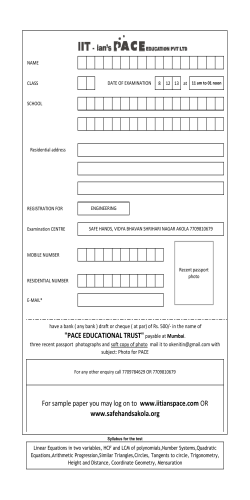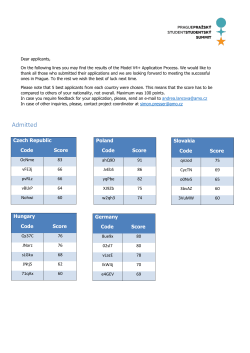
2015 Safety Net RFP - Health Care Foundation of Greater Kansas City
Safety net health care 2015 Request for Proposals OVERVIEW AND DEADLINES 1 The long term goal of the Safety Net Health Care funding is to ensure a strong Safety Net Health Care System that provides easy access to quality care resulting in better health, better care, and lower costs. Over the past 10 years, the Health Care Foundation of Greater Kansas City (HCF) has awarded nearly $54 million in funding through our safety net health care foundation funding round to improve access to health and oral health services. 2015 Safety Net Health Care RFP Goal The goal of the Safety Net RFP is to ensure that vulnerable populations have access to a strong safety net health care system that delivers high quality health and oral health care services resulting in better health, better care and lower costs through improvements. A total of $4 Million is available through the 2015 Safety net Health Care RFP. Importance of Health Equity HCF believes that health equity is achieved when every person has the opportunity to attain his/ her full health potential and no one is disadvantaged because of gender, ethnicity, where they live or economic status. HCF Overview The Health Care Foundation of Greater Kansas City is dedicated to the mission of providing leadership, advocacy and resources to promote quality health for uninsured and underserved in Kansas City, Missouri and the following counties: Cass, Jackson and Lafayette in Missouri and Allen, Johnson and Wyandotte in Kansas. Since we began grantmaking in 2005, we have dedicated more than $195 million to organizations and programs who are working toward achieving our mission and vision. For more information, visit hcfgkc.org. Deadlines Letter of Intent June 24, 2015 Full Proposal Submission August 5, 2015 Awards Announcement December 8, 2015 2 THE APPROACHES Access The timely use of personal heath care services to achieve the best health outcomes. ACCESS QUALITY When people have access to regular, affordable high quality health care their health outcomes improve. Access to Health Care requires a strong safety net health care system. HCF will support programs that facilitate access to health care services through the following strategies: 1. Provide core operating support to improve the capacity of safety net clinics, community health centers and hospitals to deliver quality health care services COST Example: Support for an organizations dayto-day expenses to enable it to deliver quality health care services. 2.Enhance community-based support services that facilitate access to health care services. Examples: Patient navigation; care coordination, patient engagement and health literacy. HCF’s Safety Net Foundation Defined Grant funding seeks to support physical and/or oral health care service delivery models that hold the promise of delivering the three-part aim of better health, better care and lower costs. Applicant projects should address one or more of the following health care and/or oral health care strategies: access, quality and cost. 3. Improve access to adequate and affordable health coverage (e.g. public insurance & the marketplace). Example: Community outreach assistance/ education required to help enroll in the health insurance marketplace, Medicaid or other public programs. When people have access to regular, affordable, high quality health care their health outcomes improve. 3 Quality Cost Health care that is patient-centered integrated across conditions, providers and settings and delivered in a way that is safe, timely, effective, efficient and equitable. Quality health care reduces overall health care costs through improvements. HCF will support programs that deliver high quality health care services and is interested in the following strategies: 1. Implementation of evidence-based and best/ promising practices. Examples: Patient-centered medical homes/health homes; Population management of complex, high risk and costly patients; Chronic disease management; Team-based care; Care Coordination; Transitions of Care; Integration of primary, behavioral and/or oral health services; Oral health preventative and treatment services 2. Improve patient care experience & engagement. Examples: Patient experience of care as safe, timely, effective, efficient and equitable. Patient engagement/ activation in self-management strategies. 3. Support the adoption of health information technology (HIT) and the use of health data to improve health outcomes/care. Through this RFP, HCF will support projects that demonstrate an interest in understanding and testing cost and savings strategies (i.e., total dollars/utilization cost, cost per person [PMPM]) that may result from their project intervention. HCF is particularly interested in the following strategies: 1. Support projects that identify/test a method to assess and evaluate the potential cost/ savings of program interventions Example: Design, test and spread methods to improve quality and reduce costs for patients with chronic conditions including preventative care and readmissions 2. Support multi-sector partnerships to collect/ reflect costs to vulnerable populations. 3. Support multi-sector partnerships to develop and test payment methods that reward value in health care. 4. Support policy changes that promote reimbursements models that reward value in health care. 4. Promote workforce innovations that address health care system transformation and/or practice redesign. Example: Community health workers to coordinate care; promote patient engagement; address social determinates of health; Team-based Care 5. Development of a community-integrated health system. (Please refer to Safety Net Health Care Neighborhood Figure). Example: Integrated health care networks partnering with Public Health & community organizations to reduce community health risk factors & provide coordinated health care. Community based organizations partner/collaborate with health care system to improve access to quality care. 4 KEY CONCEPTS Safety Net Health Care Neighborhood Integrated health and social service delivery system HEALTH DATA QUALITY & PROCESS MEASURES Healthy Environments and Food Oral Health Safe Parks and Recreation Public Health Safe Housing/ Shelters Behavioral Health Schools and Child Care Primary Care Provider/ Team-based Care Hospital Church/ Faith-based Services Public Assistance (Food stamps, TANF, WIC, Child Care) Specialty Care Patient Home Health and Hospice (and Family) Disease Specific Community Support Services Emergency Assistance Diagnostic Imaging Payers Senior Services Pharmacy Law Enforcement and Corrections Community Health Clinics Rehabilitation/ Disabilities Urgent Care Transportation IHI Triple Aim :Better Health, Better Care, Reduced Cost Quality Care: Safe and Effective, Timely and Efficient, Patient-centered and Equitable The Safety Net Health Care System The medical Safety Net is composed of a network of free health clinics, charitable clinics, Community Health Centers (FQHC’s), safety net hospitals and local public health institutions. The diversity of the Safety Net is one of its greatest strengths. This diversity allows patients to be served in the locations they choose, allows the institutions to adapt to local needs and allows different providers to develop areas of special focus or expertise. Safety Net agencies work with a range of private and nonprofit organizations to serve the many needs of lowincome patient. These partnerships include service agencies that provide adjunctive services at the local level, advocacy groups working on behalf of the under and uninsured, the research community, academia, and an array of faith, civic and voluntary groups. 5 Care Coordination Model MEDICAL HOME Accountability Patient Support Relationships & Agreements Connectivity Community Agencies Hospitals and ERs Medical Specialists Involved providers receive the information they need when they need it Practice knows the status of all referrals/transitions involving its panel Patients report receiving help in coordinating care High-quality referrals and transitions for providers and patients The MacColl Institute for Healthcare Innovation, Group Health Cooperative © 2010 Integrated Care The provision of comprehensive, coordinated and continuous services that provide a seamless process of care. • Comprehensive care addresses any health problem at any given stage of a patient’s life cycle. • Coordinated care is the provision of a combination of health services and information that meets a patient’s needs. It attempts to reduce fragmentation and improve the quality of referrals, transitions and response to social service needs • Continuous care is delivered over time by a single individual or a health care team and includes the effective and timely communication of health information. To achieve integration we need to promote changes in provider culture, redesign payment methods and incentives, and modernize federal laws. (IOM) Care Coordination Care coordination is the deliberate integration of patient care activities between two or more participants involved in a patient’s care to facilitate the appropriate delivery of health care services. It involves activities and interventions that attempt to reduce fragmentation and improve the quality of referrals, transitions and response to social service needs. Patient-Centered Medical Home Principles • Ongoing relationship with a primary care provider • Care team who collectively take responsibility for ongoing care • Whole person orientation provides all health care or makes referrals • Care is coordinated and/or integrated • Quality and safety are hallmarks • Enhanced access to care is available • Payment appropriately recognizes the added value 6 MEASURING SUCCESS HCF believes that the Triple Aim – dedicated to improving the experience of care, the health of populations and lowering the cost of care—can be used by health care providers and the health care system to focus their efforts and measure improvements and successes in quality, outcomes and reducing costs. The IHI Triple Aim A framework developed by the Institute for Healthcare Improvement (IHI) that describes an approach to optimizing health system performance. It is IHI’s belief that new designs must be developed to simultaneously pursue three dimensions or the “Triple Aim”. The three dimensions of the Triple Aim are: 1. Better Health: Improving the health of populations. 2. Better Care: Improving the patient experience of care (including quality and satisfaction) along the IOM six domains of quality: Safety, timeliness, patient-centeredness, efficiency, effectiveness and equity 3. Lower Costs: Reducing the per capita cost of health care through improvements in care and patient experience. 7 HCF encourages applicants to review the Triple Aim Goals and Measures and if appropriate use it to inform/guide the projects outcomes framework. A guide to measuring the Triple Aim can be found at: www.ihi.org/resources/Pages/ IHIWhitePapers/AGuidetoMeasuringTripleAim.aspx Other guidelines you should consider when developing the project’s evaluation plan include the following: • The evaluation plan contains sufficient procedures and rigor to determine if program services/interventions are having the intended effect. Indicators that will be used to measure achievements are clearly defined. • Outcomes should be realistic, meaningful and measurable. • When implementing Evidence-Base-Practice (EBP) the evaluation plan should include outcomes and indicators that have been reported as valid measures for practice achievement. THE APPLICATION PROCESS All organizations interested in applying for a 2015 Safety Net Health Care grant will be expected to complete the online grant application available at hcfgkc.org. Cities, hospitals and universities are allowed to submit two proposals per each Foundation Defined Grant round. Step 1: Letter of Intent and Attachments Applicants are required to submit a Letter of Intent. It should include a completed online application form and the following attachments: 1. Letter of Intent Narrative The application process requires applicants to complete two steps: Letter of Intent and Full Proposal. Both steps include a number of required attachments, which can be found at hcfgkc.org. Please ensure you are using the current 2015 templates from HCF’s website. Do not use any previous templates you may have downloaded. 2. 501(c )(3) IRS Letter of Determination Applicants will receive an email confirming receipt of the application. The email will contain an electronic link to access the full application for Step 2. If an email confirmation is not received within 24-hours, please contact the Foundation. Step 2: Full Proposal and Attachments The full proposal should include an updated online application and the information indicated below. 1. Proposal Narrative a.Abstract b. Need statement c. Project overview d. Diversity and cultural competency information Deadline The deadline for submitting the Letter of Intent application is June 24, 2015. The deadline for submitting the full proposal is August 5, 2015. The Letter of Intent and Full Proposals are due at 12:00 p.m. (noon) on the deadline days. 2. Supporting Attachments e. Project budget and narrative f. Letters of commitment and/or support g. Board roster & demographics h. Applicant’s operating budget i. Logic model (recommended) j. Most recent independent financial audit k. IRS 990 and IRS Letter of Determination l. Certificate of incorporation For more information, please refer to the Frequently Asked Questions at hcfgkc.org/faq. In addition, we would like to encourage applicants to contact us via telephone or email with any questions. Organizations that lack the capacity to complete the electronic grant application should contact Karen Guile at 816-241-7006 or [email protected]. 8 THE SELECTION PROCESS After an initial internal review process, a team of reviewers from outside HCF’s service area will make recommendations for grant funding. External reviewers may also recommend further negotiation, modification or technical assistance in lieu of grant funding. HCF associates will make the final decision on the slate of recommendations in response to external reviewers’ guidance and HCF Board direction. These recommendations will be presented to the Program/Grants Committee for consideration before they are approved or declined by vote of the HCF Board of Directors. Securing additional funds from other sources to support your project is important to the Foundation. The Foundation will consider requests for no more than 75 percent of the cost of the proposed project. It is recommended that the remaining funds use a balanced approach of cash and in-kind resources. The Health Care Foundation will not fund more than 50 percent of an organization’s operating budget. [Note – this includes the sum of all current grants HCF has with the organization.] The Foundation reserves the right to reject proposals submitted, to request additional information or clarification from any or all applicants, and/ or negotiate changes with applicants at any time before, during or after the award process. Grant awards are made at the sole discretion of the Foundation. No entitlement to funding for any organization at any level is expressed or implied. Successful applicants enter into a contract that gives the Foundation rights to review and evaluate grant-funded activities. Review Process Internal Review Process External Reviewers Board Approval Awards Announced 9 DATA AND RESOURCES It is highly recommended that you use current local or regional data in your grant application needs section. Safety Net Health Care resources are available at hcfgkc.org. HCF also encourages you to visit is kchealthmatters.org, a one-stop resource for local health data and promising practices. Data is available for the six counties in our service area. The site is intended to help community organizations and coalitions learn about health issues, plan for improvements, and collaborate for positive change. Features of the site include: • Community Dashboard provides an overview of the indicators for each of the six counties in the HCF service area. A small number of data points are available at the zip code and census tract level. • Disparities Dashboard that can be used to examine difference in health status based on age, race/ethnicity and gender. • Healthy People 2020 Tracker to compare a county’s status on a number of health issues with 2020 goals. • Demographics Dashboard provides demographic data such as income, race, poverty status and educational attainment for each community. • Promising Practices with a repository of more than 800 locally and nationally recognized practices to be tailored and replicated in other communities. • Report Center to view a repository of published reports, web content, fact sheets and planning documents. For More Information • Report Assistant and Indicator Comparison reporting tools to integrate the site content into customized reports. Additional resources can be found at hcfgkc.org. Contact Graciela Couchonnal at [email protected] or Andres Dominguez at [email protected] or call 816-241-7006. 10
© Copyright 2025









